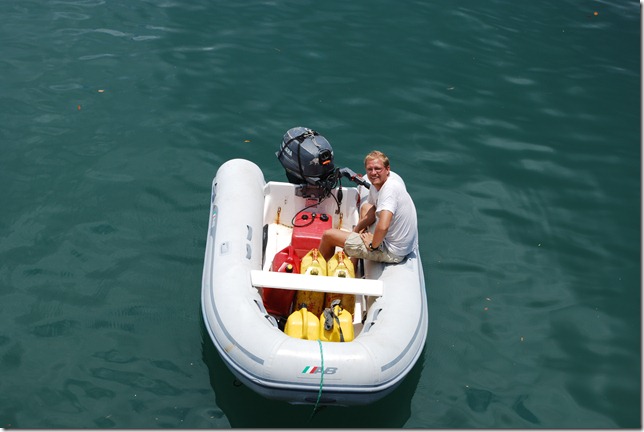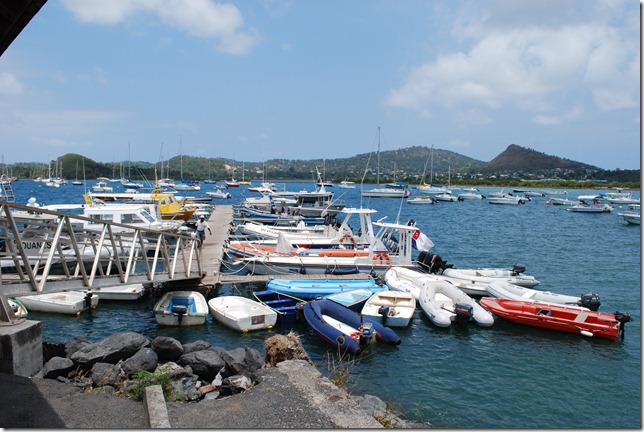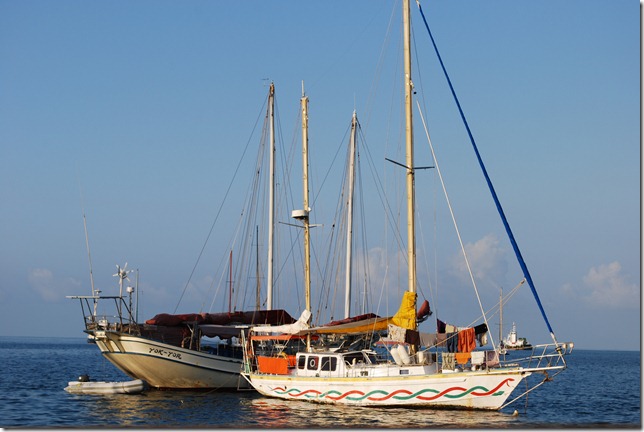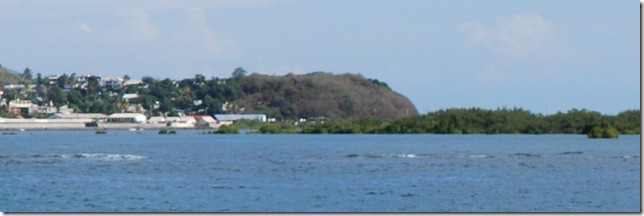So far, our stop in Mayotte has been productive, but we haven’t had much time for being tourists. Our first few days have been spent checking in, provisioning, knocking out the list of required boat repairs, updating the website, doing 5 weeks of laundry (not as much as you’d think with four of the weeks spent offshore), and jugging diesel and water to fill the tanks. The part for the rigging arrived at the airport on Friday, but won’t clear customs until today (Monday), so we’re planning to check out today, hope it fits, and leave on Tuesday morning. We’d love to stay longer and explore a bit, but we’re getting reminders that it’s time to be moving along. The first tropical disturbance and cyclone of the season have both occurred already. We were just in time to pass ahead of the tropical disturbance as we crossed the Indian Ocean, and the first cyclone was behind us as well, nearly hitting Cocos Keeling several weeks after we left. With the SW monsoon ending, the Somali pirates are moving south as well. Last week they captured a vessel en route from Tanzania to the Comoros, of which Mayotte is a disputed part. They’re still north of us, but the 200-mile buffer zone I’d planned to keep between us and any known Somali pirate attack is shrinking this year, made smaller by our stop in Mayotte, and really doesn’t seem like a lot once you’re here.
 Bringing the diesel jugs in to the fuel station atop a rocky wharf
Bringing the diesel jugs in to the fuel station atop a rocky wharf
 The finger pier used by dinghies wobbles so much that it seems like a water park gizmo meant to get you wet
The finger pier used by dinghies wobbles so much that it seems like a water park gizmo meant to get you wet
We’re getting a heavy rain this morning, which, along with the hot days of light wind is yet another sign of the changing monsoon. The Indian Ocean is different from the Atlantic and Pacific in that the North Indian Ocean is a “two-way” ocean subject to monsoons (from the Arabic word for fixed seasons). The prevailing wind direction in the North Indian Ocean changes from SW (May to October) to NE (November to March) annually, with the SW monsoon generally bringing more rain, and the transition between monsoons being a period of light winds and heavy rainstorms. The North Indian Ocean monsoons have been useful for sailors for centuries because they let you sail downwind across the ocean in both directions if you time your passage for the proper monsoon. Our current location in the northern part of the South Indian ocean at the end of the SW monsoon means that the trades in the area will be pushed south and replaced by the doldrums and squalls of the ITCZ in the next couple of months as it makes its yearly migration to the south accompanying the NE monsoon.
The anchorage here in Dzaoudzi is an interesting one. It’s about 50 feet deep, which is OK for anchoring, but you’d want to put out at least 200’ of chain, which means you’d need quite a distance between you and adjacent boats to avoid swinging into each other. Moorings have been laid instead, as there are a lot of French live-aboard boats here. Unfortunately, the moorings haven’t been planned very well and many leave boats within swinging distance of each other. Last night, with the very light winds and strange currents here, we bumped the boat next to us and saw other boats fending off as well. We were lucky to find an open mooring whose owner let us stay here for free. The other interesting thing about this mooring is the tidal lake beside it. At high tide, water from the lagoon flows into the lake, and at low tide the edge of the lake is like a waterfall, with rivers of water cascading into the anchorage. It makes a fun place for local kids to play, and the current is one of the reasons that the boats end up in odd orientations here. At the edge of the anchorage is the Blue Water Cruising Association of Mayotte. It would fall into the generally category of “yacht club” but is really more of a glorified boatyard serving the numerous French sailors that live aboard on moorings and on the hard. The bar is actually a shipping container with a service window cut in the side that is lifted with a sailing block and line in the morning and then dropped and locked at night. It is only approachable by dinghy during the upper half of the tide, but that timing has worked out well for us during our stay. Tide has been high right around shower time. We’ve enjoyed a couple of the refreshing cold water showers with a knob that you push to get about 5 seconds of water, just like the knobs on water-conserving sinks in public restrooms in the US.
 Local kids playing in the waterfalls created by the tidal lake
Local kids playing in the waterfalls created by the tidal lake
 Two boats doing the Dzaoudzi light wind tango
Two boats doing the Dzaoudzi light wind tango
We have managed to avail ourselves of one of the French luxuries that Wes introduced me to – bread, cheese & wine. The French territories always have fresh baguettes, and the boulangeries here make an excellent assortment of fresh bread daily. The cheese selection in the supermarket, which is usually very limited in remote places, would rival an upscale US grocery store, and the wine selection is unusually diverse and cheap, with numerous French and South African selections. We were snacking on bread and cheese at the “yacht club” yesterday evening when I commented on the good cheese to one of the friendly Frenchman who’d come over to visit with us. He took a look at our selection and grunted with a disinterested air, “Hmmm, cooking cheese.” Ahh the French. We’d forgotten about the unique and numerous mannerisms they have. I can’t really think of a parallel in the US for the characteristic French hand gestures and facial expressions that often accompany or substitute for common descriptive expressions.
The combined cyclone risk and virtual guarantee of a southerly ‘buster’ or two that will make for dangerous wave states when it opposes the strong southerly current may make the passage from here to South Africa one of our tougher ones. If the weather cooperates, we’re planning to move south as quickly as possible until we get to the south part of the Mozambique channel where the busters are common. From there to South Africa, we’ll try to move when the winds are good and duck into an anchorage in Mozambique when the winds come from the south. Once we get closer to Mozambique, we should be in the south-setting Mozambique current while we’re moving, which will give us a boost.
Now if only the downpour would stop so we can run our final errands without getting soaked…


